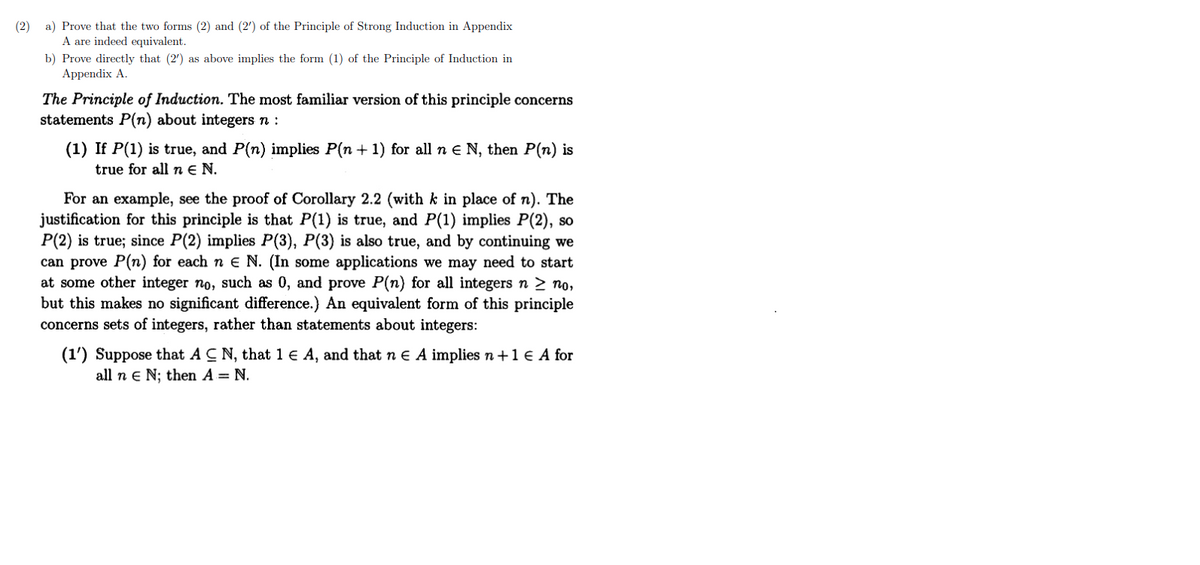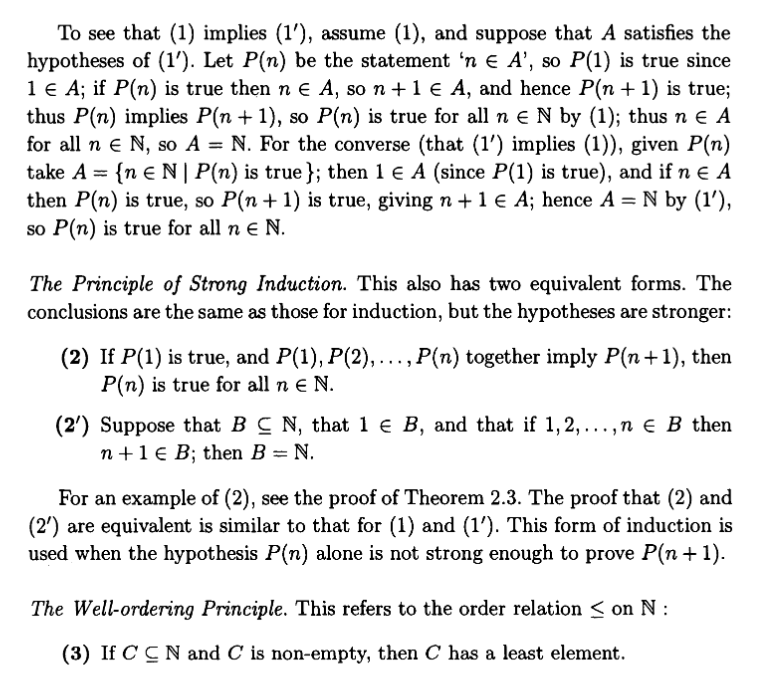a) Prove that the two forms (2) and (2) of the Principle of Strong Induction in Appendix A are indeed equivalent. b) Prove directly that (2') as above implies the form (1) of the Principle of Induction in Appendix A. The Principle of Induction. The most familiar version of this principle concerns statements P(n) about integers n (1) If P(1) is true, and P(n) implies P(n + 1) for all n € N, then P(n) is true for all neN.
a) Prove that the two forms (2) and (2) of the Principle of Strong Induction in Appendix A are indeed equivalent. b) Prove directly that (2') as above implies the form (1) of the Principle of Induction in Appendix A. The Principle of Induction. The most familiar version of this principle concerns statements P(n) about integers n (1) If P(1) is true, and P(n) implies P(n + 1) for all n € N, then P(n) is true for all neN.
Elements Of Modern Algebra
8th Edition
ISBN:9781285463230
Author:Gilbert, Linda, Jimmie
Publisher:Gilbert, Linda, Jimmie
Chapter2: The Integers
Section2.3: Divisibility
Problem 49E: 49. a. The binomial coefficients are defined in Exercise of Section. Use
induction on to prove...
Related questions
Question
Please help me.

Transcribed Image Text:(2)
a) Prove that the two forms (2) and (2') of the Principle of Strong Induction in Appendix
A are indeed equivalent.
b) Prove directly that (2') as above implies the form (1) of the Principle of Induction in
Appendix A.
The Principle of Induction. The most familiar version of this principle concerns
statements P(n) about integers n :
(1) If P(1) is true, and P(n) implies P(n + 1) for all n ≤ N, then P(n) is
true for all nЄN.
For an example, see the proof of Corollary 2.2 (with k in place of n). The
justification for this principle is that P(1) is true, and P(1) implies P(2), so
P(2) is true; since P(2) implies P(3), P(3) is also true, and by continuing we
can prove P(n) for each ne N. (In some applications we may need to start
at some other integer no, such as 0, and prove P(n) for all integers n ≥ no,
but this makes no significant difference.) An equivalent form of this principle
concerns sets of integers, rather than statements about integers:
(1') Suppose that A CN, that 1 € A, and that n € A implies n + 1 € A for
all n E N; then A= N.

Transcribed Image Text:To see that (1) implies (1'), assume (1), and suppose that A satisfies the
hypotheses of (1'). Let P(n) be the statement 'n € A', so P(1) is true since
1 € A; if P(n) is true then n € A, so n + 1 € A, and hence P(n + 1) is true;
thus P(n) implies P(n+1), so P(n) is true for all n € N by (1); thus ne A
for all ne N, so A = N. For the converse (that (1') implies (1)), given P(n)
take A = {ne N | P(n) is true }; then 1 € A (since P(1) is true), and if n € A
then P(n) is true, so P(n + 1) is true, giving n + 1 € A; hence A = N by (1'),
so P(n) is true for all n € N.
The Principle of Strong Induction. This also has two equivalent forms. The
conclusions are the same as those for induction, but the hypotheses are stronger:
(2) If P(1) is true, and P(1), P(2), …….., P(n) together imply P(n+1), then
P(n) is true for all n € N.
(2') Suppose that BCN, that 1 € B, and that if 1,2,...,n € B then
n+ 1 € B; then B = N.
For an example of (2), see the proof of Theorem 2.3. The proof that (2) and
(2') are equivalent is similar to that for (1) and (1′). This form of induction is
used when the hypothesis P(n) alone is not strong enough to prove P(n+1).
The Well-ordering Principle. This refers to the order relation on N:
(3) If CCN and C is non-empty, then C has a least element.
Expert Solution
This question has been solved!
Explore an expertly crafted, step-by-step solution for a thorough understanding of key concepts.
Step by step
Solved in 3 steps

Recommended textbooks for you

Elements Of Modern Algebra
Algebra
ISBN:
9781285463230
Author:
Gilbert, Linda, Jimmie
Publisher:
Cengage Learning,

Algebra & Trigonometry with Analytic Geometry
Algebra
ISBN:
9781133382119
Author:
Swokowski
Publisher:
Cengage

Linear Algebra: A Modern Introduction
Algebra
ISBN:
9781285463247
Author:
David Poole
Publisher:
Cengage Learning

Elements Of Modern Algebra
Algebra
ISBN:
9781285463230
Author:
Gilbert, Linda, Jimmie
Publisher:
Cengage Learning,

Algebra & Trigonometry with Analytic Geometry
Algebra
ISBN:
9781133382119
Author:
Swokowski
Publisher:
Cengage

Linear Algebra: A Modern Introduction
Algebra
ISBN:
9781285463247
Author:
David Poole
Publisher:
Cengage Learning